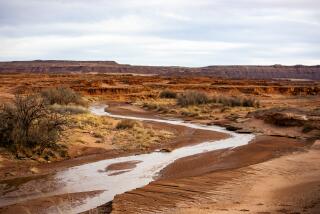Colorado River Leaves No Doubt as It Asserts Itself in the West
- Share via
Like some divine sculptor, the Colorado River molded the landscape of the West, its muddy waters pounding away over millions of years at rock and earth, from the Rocky Mountains through the deserts to the Gulf of California.
Slowly, the river carved mountain ranges, deep orange sandstone canyons, rivers, streams and tiny washes that ripple like veins across the desert.
Over the last century, however, the twisting, churning lines of the Colorado have been redrawn by the hand of man, who turned a wild river into ruler-straight channels too weak to reach the sea. Dammed, drained and diverted into canals and underground pipelines, the Colorado now serves Western growth--a plumbing system in the desert for cities with pools and golf courses and millions of acres of wheat, alfalfa and other crops.
The cost has been high. One of the most managed rivers in the world, the Colorado is also considered one of the most threatened, saltier in some places than the ocean and occasionally deadly for endangered fish and birds such as the razorback sucker and brown pelican.
For 20 million people in seven states and Mexico dependent upon the Colorado, the ecological damage is a blaring beacon: The West has asked too much from the Colorado. Now, after decades of viewing the river as a giant spigot, the West is undergoing a river revolution.
States are frantically storing their allotted water underground or trying to bargain with other less developed states for their shares. Environmentalists are filing--and winning--lawsuits, the cost of hydropower is rising, and the federal government is spending millions to resuscitate the Colorado, staging an artificial flood in the Grand Canyon and pumping water into dying wetlands in Utah and Mexico. Native American tribes are demanding their share of the dwindling river, and farmers are bracing for an assault on government subsidies that made it cheap to grow food in the desert.
The history of the Colorado has been about change, river-wrought and man-made. But one thing may never change: the Colorado River Compact, one of the oldest and most powerful pieces of water law in the West.
Approved in 1922, the compact marked the beginning of the development of the Colorado, and in many ways, the West. It divided the water between the Upper Basin states--New Mexico, Utah, Colorado and Wyoming--and the Lower Basin states of Arizona, California and Nevada.
Intensely debated and litigated for nearly a decade, the compact remains the basis for who gets what in the West.
The tension between the two river basins over control of the Colorado rages on, with the slower-growing Upper Basin looking to judges and lawmakers to force Lower Basin cities like Las Vegas and Los Angeles to limit their thirst for the river.
People have spent a century pushing and pulling at the river, trying to reshape it to meet the dream of a wild, open West, a place without limits. Now the Colorado is making it clear: That was only a dream.
But will anyone care until they turn on the faucet and nothing comes out?
*
For thousands of years, no one worried about using up the river.
Indigenous tribes like the Cocopa in northern Mexico and the Havasupai in Arizona lived along the Colorado, depending upon it for food and spiritual sustenance. White settlers since the 1500s wrote about the bounties of the Colorado, and how it made life in the desert possible.
The river that explorers wrote about was mighty: warm, muddy, red, churning and terrifying when it flooded. The Spanish sometimes called it Rio de la Buena Guia, “River of the Good Guide,” and Rio de la Buena Esperanza, “River of Good Hope.” Native people called it “The River,” for it was the only one they knew.
Photographs taken in southern Arizona in the early 1900s show women in frocks and bonnets, waving from huge riverboats and parades celebrating the first dams--the ultimate symbol of human superiority over nature and survival in the desert.
That river is long gone.
Today, every drop of the Colorado is used 17 times, herded through 49 dams and dozens more canals and pipelines from the river’s headwaters in Colorado, 1,450 miles to the Gulf of California in Mexico. Some consider its bottom half a concrete-lined ditch below Hoover Dam on the Arizona-Nevada line.
Naturally a very turbid river, the Colorado now runs clear and cold and green-blue, its sediment trapped behind the dams. Nonnative sport fish from as far away as Africa outnumber and threaten native fish, and more than 100 species are considered endangered in the lower half of the river alone. Even the salt cedar trees lining the river in the Grand Canyon are imported.
Once, U.S. Bureau of Reclamation officials were considered the heroes of Western expansion. Now, they acknowledge that the era of big dams is over. Too expensive and too much environmental damage, they say.
“They’ve taken a wild river and tamed it,” said Gary Taylor, Reclamation spokesman in Yuma, Ariz., where a $256-million desalting plant was built in 1992 to purge water of desert salts and pollutants.
“Sometimes I can’t imagine that it used to look like this,” Taylor said, holding up a faded photo. “Wide enough for a big bridge and boats. It’s amazing.”
And so began the development of the Colorado River.
Driven at first by the faster-growing Lower Basin states, the federal government used the Colorado to fuel the engine of Western development.
Laws were passed--complex and endlessly litigated compacts and treaties worth billions that divvied up every drop of the Colorado between the states, Indian tribes and Mexico.
Engineers built dams and canals to deliver water to farms and turned scorched brown earth into lush fields of grains and cotton. Sleepy desert towns like Phoenix, Las Vegas and Salt Lake City were transformed into sprawling metropolises, complete with lawns, pools and golf courses.
The slower-growing states of the Upper Basin watched with mounting horror as the Lower Basin bloomed and boomed, swallowing more water each day. They built dams so that their portion of the Colorado would be there as they developed.
Behind the dams, enormous reservoirs were created that took years to fill; the Colorado ran for 17 years behind Glen Canyon Dam until Lake Powell was made. Lake Mead became the nation’s largest man-made reservoir, holding enough water to cover the state of Pennsylvania with a foot of water.
With the river tamed and roads built, millions of Westerners discovered that they, too, could ply the waters that John Wesley Powell explored in wooden boats in the summer of 1869. They came to water-ski, fish and swim.
Sportfishing grew in popularity and anglers stocked the Colorado with nonnative trout, carp and salmon, which competed with natives like the Colorado squawfish, humpback chubs and vaquita, one of the world’s smallest porpoises. They are all endangered today.
From the dried-up Mexican delta to Hoover Dam, the Colorado will never return to its pristine, pre-development days. But after spending most of the century dividing up the river and then developing it, the West is coming to new terms with its provider.
“We have evolved a new relationship with us as a society and our environment,” said David Wegner, a Reclamation scientist on the Colorado for more than 20 years. “There’s no longer a hill to climb and it’s green on the other side. All the hills have been climbed, all the rivers have been dammed.”
The new paradigm has spurred a flurry of river research and ideas of every kind are on the table.
Wegner, now a consultant, and a group of environmentalists and scientists are proposing draining Lake Powell to restore both Glen Canyon--now swamped under Powell--and the Grand Canyon.
Other changes are anticipated. State governments are proposing leasing and borrowing water from one another. Million-dollar conservation projects have been launched to restore wetlands and reconstruct fish and bird habitat like the Cienega de Santa Clara in Mexico.
After operating dams for decades for the convenience of power companies, the government now considers the river environment and tries to more closely mimic Mother Nature--a philosophical shift that has cost the power industry millions.
Power companies are beginning to question the value of hydroelectric power, saying they don’t want to pay for environmental studies now required. The cost of federal power from the Colorado has doubled since 1988, mostly because of such studies.
Things may also change for farmers, who use about three-quarters of allotted Colorado River water--water heavily subsidized by the federal government. Among the most common crops are alfalfa and other low-value, water-intensive plants.
“Why should we put water on salty land on subsidized crops?” Wegner said. “It’s a question of what society values.”
Even efforts at conservation and restoration, such as more efficient shower heads and improved irrigation systems, are ultimately nothing but Band-aids.
“You have to start thinking, for what reason are we conserving the water? If all it’s meant to do is free up some water for more urban development and golf courses in the desert, we’ll never escape the problems we’re facing with ecological degradation and water shortages,” said Jason Morrison, co-author of a recent study on sustainable use of Colorado River water and an associate of the Pacific Institute in Oakland. “The thing people have to come to terms with is the philosophical shift that we must live within the resources.”
*
For people in the West, living within the resources has become more than just a philosophical concept.
In an effort to conserve, cities including Las Vegas fine residents who water their lawns in the summer during certain hours. Authorities have banned new housing developments featuring lakes, encouraged desert landscaping and limited the size of grass lawns with new homes. People in Los Angeles are required to have low-flow toilets and faucets and forbidden from letting hoses run without reason.
There is no question that the Colorado is reasserting itself in the West.
No city code, state court action or federal law can put water back into the river or wash away the well-entrenched water needs of millions of Westerners. It will take more than conservation and recycling, more than desalting undrinkable water and more sacrifice than any lawsuit or legislator can mandate. But there is no choice: The Colorado has spoken.
“I try to go where I can’t smell any stinking reservoirs, but it’s getting harder,” says Katie Lee, a grizzled folk singer and river runner who was among the first white women to raft the Colorado through Glen Canyon in the 1950s. Calling Glen “her lover,” Lee actually named dozens of its side canyons and penned an album of songs about the river.
Now 77, Lee hasn’t been back on the Colorado since 1956, when Glen Canyon Dam was built. She has searched the Earth for a river that runs free.
“I had to go to the Noatak River--do you know where that is? It’s north of the Arctic Circle,” she said, her voice cracking. “Poor Colorado.”
More to Read
Sign up for Essential California
The most important California stories and recommendations in your inbox every morning.
You may occasionally receive promotional content from the Los Angeles Times.










